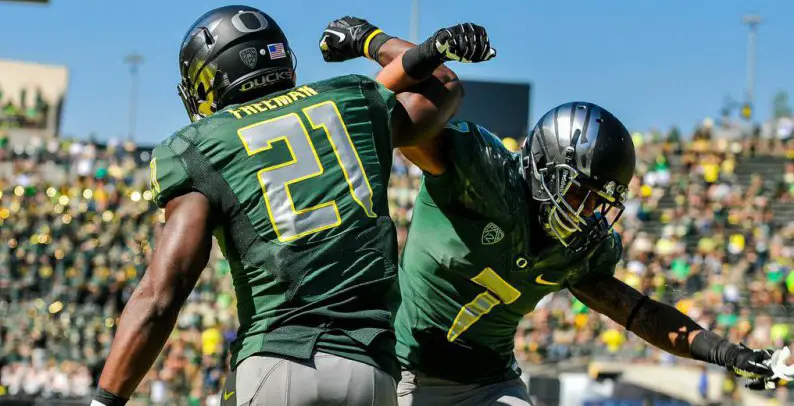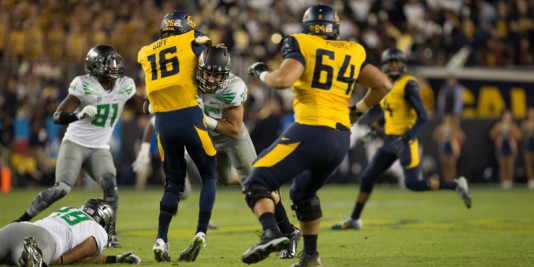As Duck fans we are biased. We’re also fanatical, Hawaiian-crazy, freshmen-frenzied football fans who are in the midst of watching one of the many great Duck teams and Duck players of all time. Watching Marcus Mariota slash and gash defenses for touchdown after touchdown is not something we should get used to since players as good as he is only come around once in a blue moon.
Over the past few games though, Duck fans have witnessed something truly special. In the course of the past five games, Mariota and company have defeated two top 20 teams, the number one and number two pass-rushing teams in the nation. In addition, they have successfully defended against the seventh ranked offense and scored many points against the second ranked defense in the nation in back-to-back games. Now that’s a freaking resume.
So, of course, we Duck fans fully understand the jump to number two in the College Football Playoff Rankings over the undefeated Florida State Seminoles. Yet, as hard as this is to admit, not everyone in the world is a Duck fan. So here is a brief, and unbiased, examination of three questions regarding the Ducks’ significant and justified jump.
Question 1: How can a one-loss team rank higher than an undefeated team?
If there were a poll of most American football fans asking how many undefeated teams were left among all FBS schools, I would assume an overwhelming majority would say two: Mississippi State and Florida State. Both are in the top four in the CFP Rankings and as of last week they were a respective one and two. Guess what though? There are three teams.
Conference USA’s very own Marshall is 9-0, but they aren’t even in the top 25 of the rankings. This is because the CFP Committee measures teams’ rankings by a list of quality wins and strength of schedule. So, when one compares Marshall’s schedule and Mississippi State’s schedule, the two are in separate worlds. When one compares Oregon and Florida State, it’s clear that Oregon has far more quality wins and a much more difficult schedule the FSU.
Question 2: How can one truly define a quality win?
Easy. A quality win is against any team with a winning record or a top 25 ranked team. So, although FSU is undefeated, Oregon has won five out of six games against quality opponents, and that number of wins can be moved to six if the Cal game counts as a quality win, which it should.
FSU on the other hand has played four, maybe five games against quality opponents and their average margin of victory was only 6.6 points per game. What about the Ducks? Even if one includes their loss to a solid Arizona team into their margin of victory, the Ducks have won their quality games, including the Cal game, by a whopping average of 17.1 points per game. That’s including a loss.
Question 3: Could FSU Reclaim the Second Spot?
In short, yes. FSU has three more games to play, all against quality opponents. They play a Miami team that’s 4-1 in their last five games, a Boston College team that beat USC earlier in the season and even a Florida team whose only three losses came to teams in the SEC with a combined record of 22-6. Needless to say, winning all three of these games would be quite a statement, whereas Oregon’s two victories against Oregon State and Colorado would hardly turn any heads. When all is said and done though, no one really knows what the CFP Committee is thinking until the following Tuesday, so all we Duck fans can do is sit at home and cross our fingers.
Top photo from Craig Strobeck
Related Articles:
Chip Kelly Update: Everything's Good Again ...
Chip Kelly Update: Wailing and Gnashing of Teeth
Shock and Awe -- The Oregon Ducks' Football Hangover Effect
Despite Lopsided Score, Georgia State "Never Stopped Believing"
Hope Springs Eternal for Ducks
Incompetent Pac-12 Officials: How Do You Miss ALL of THIS?
Caleb is a sophomore at the University of Oregon intending to double major in Journalism and Sports Management. He is the Managing Editor for FishDuck.com, along with being a lifetime Saints and San Francisco Giants fan, as Caleb fell in love with sports at a young age and developed that love into a passion for sports analysis. He is looking forward to cheering on the Ducks throughout his career at Oregon, and is always willing to talk sports with any fellow fan.



